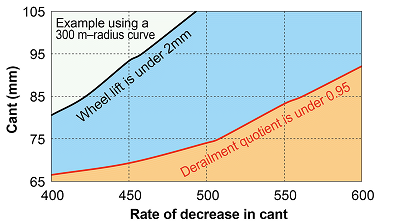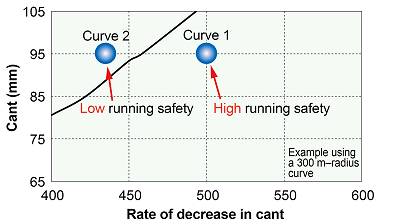6. Method for evaluating running safety in case of punctured air spring
Damage to equipment or air piping on a railway vehicle can lead to a punctured air spring. This punctured state may be created on purpose with a view to prevent vertical train set buckling, in case of relief assistance. In these situations, the rigidity in vertical vehicle support increases, while the vehicle’s ability to follow the twist irregularity of the track worsens and decrease of wheel load increases. A method was designed therefore to assess running safety in these conditions, in accordance with curve parameters.
The graph in Fig. 1 shows the case where either wheel lift is lower than 2mm or the derailment coefficient is within the admissible limit (modified arc wheel profile 0.95) based on the combined analysis of cant and the cant reduction amplification factor.
When wheel lift is lower than 2mm, there is only one point of no contact between the flat part of the wheel flange and the rail, which means that rail climb has not begun. On the same graph, in the case of a punctured air spring, even if the derailment coefficient is exceeded, a buffer zone still exists before rail climb begins. As such, a proposal was made to use wheel lift as an indicator to directly determine the level of safety in case of rail climb.
If graphs such as the one in Fig. 1 are prepared in advance for various types of vehicle and conditions, railway operators will be able to assess running safety with a punctured air spring. Fig. 2 shows an image of the proposed method where the parameters of curves located along lines to be used for a relief run or empty run back to the shed, have been plotted, and the wheel lift threshold value of 2mm can be used to determine running safety.
For curves where the safety level is found to be low, tests in RTRI test facilities conformed that friction modifiers or water can be spread or sprayed on the rail head of the inner rail of the exit transition curve in order to mitigate wheel lift.
Application of this method will make it possible to anticipate sections of track where similar measures should be taken in the case of an air spring puncture, during empty runs back to the shed or relief runs.
Other Contents
- 1. Effectiveness of embankment slope work against cloudbursts
- 2. Development of seismic reinforcement methods for bridge abutment and proposal for new design method
- 3. Fracturing grouting as a countermeasure against soil liquefaction
- 4. Anti-seismic measures using a vibration control damper
- 5. Bogie designed to prevent flange climb derailment
- 6. Method for evaluating running safety in case of punctured air spring
- 7. Wireless communication network for monitoring of freight car condition
- 8. Development of a deterrent sound to prevent Deer-Train Collisions
- 9. Training material to prevent communication errors
- 1. Effectiveness of embankment slope work against cloudbursts
- 2. Development of seismic reinforcement methods for bridge abutment and proposal for new design method
- 3. Fracturing grouting as a countermeasure against soil liquefaction
- 4. Anti-seismic measures using a vibration control damper
- 5. Bogie designed to prevent flange climb derailment
- 6. Method for evaluating running safety in case of punctured air spring
- 7. Wireless communication network for monitoring of freight car condition
- 8. Development of a deterrent sound to prevent Deer-Train Collisions
- 9. Training material to prevent communication errors


